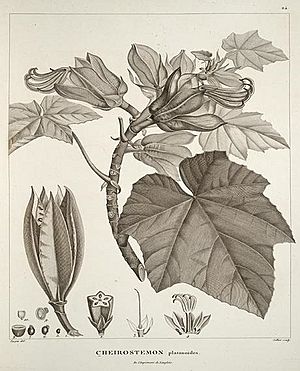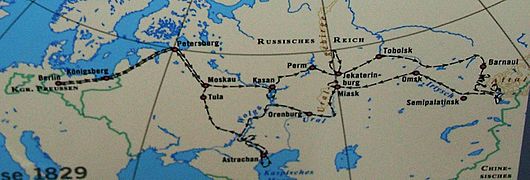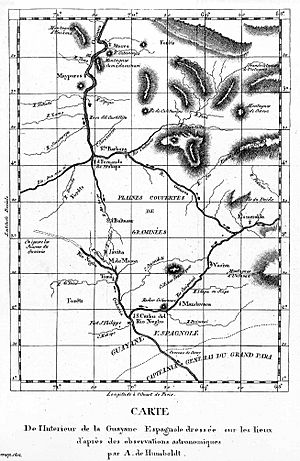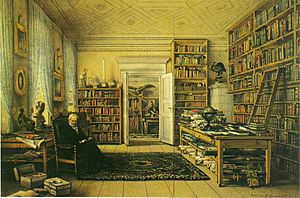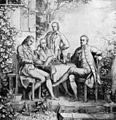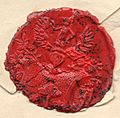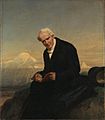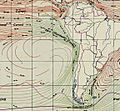Alexander von Humboldt facts for kids
Quick facts for kids
Alexander von Humboldt
|
|
|---|---|
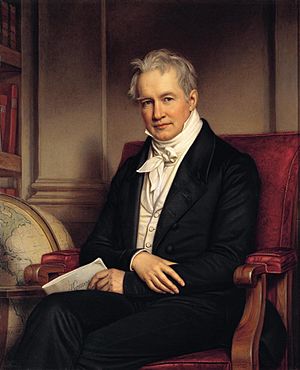
Portrait by Joseph Karl Stieler (1843)
|
|
| Born | 14 September 1769 |
| Died | 6 May 1859 (aged 89) |
| Resting place | Schloss Tegel |
| Nationality | German |
| Alma mater | Freiberg School of Mines (diploma, 1792) University of Frankfurt (Oder) (no degree) University of Göttingen (no degree) University of Berlin (no degree) |
| Known for | Biogeography, Kosmos (1845–1862), Humboldt Current, magnetic storm, Humboldtian science, Berlin Romanticism |
| Awards | Copley Medal (1852) |
| Scientific career | |
| Fields | Geography |
| Academic advisors | Markus Herz, Carl Ludwig Willdenow, Abraham Gottlob Werner |
| Notable students | Louis Agassiz |
| Influences | F. W. J. Schelling |
| Influenced | Darwin, Wallace, Thoreau, Whitman, Emerson, Muir, Irving, Ida Laura Pfeiffer, Frederic Edwin Church, Ernst Haeckel, George Perkins Marsh |
| Signature | |
Alexander von Humboldt (born September 14, 1769, in Berlin – died May 6, 1859, in Berlin) was a famous Prussian naturalist and explorer. He made huge contributions to the study of nature and the Earth. His work on plant geography was very important for the field of biogeography, which studies where plants and animals live. Many people call him "the father of ecology" and "the father of environmentalism" because he helped us understand how nature works together.
Contents
Who was Alexander von Humboldt?
Alexander von Humboldt was born in Berlin, Prussia. His father, Alexander Georg von Humboldt, was a military officer. His mother, Maria Elizabeth von Colomb, was a well-educated woman. Alexander had an older brother, Wilhelm von Humboldt, who became a famous minister and philosopher.
Even as a child, Alexander loved collecting plants, shells, and insects. This hobby earned him the nickname "the little apothecary," which is like a pharmacist or someone who studies plants for medicine. His father passed away when Alexander was young, so his mother took charge of his education.
How did Humboldt get his education?

Alexander von Humboldt studied many different subjects to prepare for his life as an explorer. In 1787, he studied finance for six months at the University of Frankfurt (Oder). Later, in 1789, he went to the University of Göttingen.
Humboldt was always passionate about travel. He wanted to be a scientific explorer. To get ready, he studied business and foreign languages in Hamburg. He learned about rocks and minerals (geology) at the Freiberg School of Mines. He also studied the body (anatomy) at the Jena and learned about stars (astronomy). He also learned how to use scientific tools.
What were Humboldt's famous travels?
Between 1799 and 1804, Humboldt traveled a lot in the Americas. He explored and described these lands for the first time from a scientific point of view. He wrote down his journey in many books over 21 years. Humboldt was one of the first people to suggest that the lands around the Atlantic Ocean were once connected. He thought that South America and Africa used to be joined together.
What did he achieve in Latin America?

Humboldt's trip laid the groundwork for new sciences. These included physical geography (the study of Earth's natural features), plant geography (where plants grow), and meteorology (the study of weather). He carefully watched plants and animals in their natural homes. He didn't just look at them alone. He noted how everything in nature was connected. He collected many plant and animal samples. He divided his collections so that if some were lost, others would still exist.
Humboldt believed that everything should be measured with the best and newest tools. This way of measuring things carefully became known as Humboldtian science.
Humboldt also studied the volcanoes in the Andes mountains and Mexico. He watched them, drew them, climbed them, and measured them with many tools. When he climbed Chimborazo, he set a new record for altitude. This record helped measure other volcanoes in the Andes and the Himalayas.
Humboldt also helped make better maps. He created maps, especially of New Spain (now Mexico), that other mapmakers used later. He counted the people living in New Spain, both native people and Europeans. He estimated there were about six million people. He found that about 40% of the people were native, but they were not spread out evenly. Most lived in central and southern Mexico.
Humboldt was not mainly an artist, but he could draw very well. This allowed him to draw what he saw in nature. Many of his drawings were used in his scientific books.
What about his expedition to Russia?
Humboldt's trip to Russia in 1829 is not as well-known as his travels in South America. The leader of Russia, Czar Nicholas I, invited Humboldt to visit the Ural Mountains. The Russian government wanted Humboldt to find new places for mining. They also wanted his help to improve trade. They knew Humboldt was interested in mining sites for his scientific studies.
In 1829, Humboldt traveled across the huge Russian empire. He went from the Neva River to the Yenisei River. In just 25 weeks, he covered about 9,614 miles (15,500 km). The trip was planned to go as far as Tobolsk, then return to Saint Petersburg. The whole journey took 8 months. He stopped at 658 places and used 12,244 horses! However, the trip was too fast to do a lot of deep scientific work. Humboldt wrote two books about his Russian trip. In 1843, he finished a three-book series called Asie Centrale, which he dedicated to Czar Nicholas.
How was Humboldt recognized for his work?
During his lifetime, Humboldt became one of the most famous people in Europe. Many scientific groups from his own country and other countries wanted him to join them.
After Mexico became independent from Spain in 1821, the Mexican government honored him greatly. They thanked him for his help to their nation. In 1827, the first President of Mexico, Guadalupe Victoria, made Humboldt a Mexican citizen. In 1859, the President of Mexico, Benito Juárez, called Humboldt a national hero. These were honorary titles, as he never returned to the Americas after his first big trip.
King Frederick William III of Prussia gave Humboldt an important job as a royal chamberlain. This job came with a good salary, which was later doubled. This money became his main income later in life. He had spent most of his own money on publishing his many research books.
On May 12, 1827, he moved back to Berlin for good. There, he focused on studying Earth's magnetism. In 1827, he started giving public talks in Berlin. These talks became the basis for his last major book, Kosmos (published from 1845–1862).
In 1869, 100 years after he was born, Humboldt was so famous that cities all over America celebrated his birthday with big parties. In New York City, a statue of his head was revealed in Central Park.
What about his travel diaries?
Humboldt kept a very detailed diary of his time in Spanish America. It was about 4,000 pages long! He used these diaries to write his many books after the trip. These leather-bound diaries are now in Germany. They were taken by the Red Army after World War II but were later returned to East Germany. After Germany became one country again, the diaries were given back to one of Humboldt's relatives. There was a worry they might be sold, but that was stopped. A project funded by the government (from 2014–2017) worked to make digital copies of his Spanish American and Russian expedition diaries. This was done by the University of Potsdam and the German State Library.
What else did he publish?

Alexander von Humboldt wrote many books throughout his life. Many of his works were first published in French or German. Then, they were translated into other languages. Sometimes, there were different translated versions. Humboldt himself didn't keep track of all the different editions. He wrote special books about plants, animals, stars, and minerals. But he also wrote general books that many people enjoyed reading. One famous one was his Personal Narrative of Travels to the Equinoctial Regions of the New Continent during the years 1799–1804. His Political Essay on the Kingdom of New Spain was read widely in Mexico, the United States, and Europe.
Many of his original works have been scanned and put online by the Biodiversity Library. New printed versions of his books have also come out. This includes his Views of the Cordilleras and Monuments of the Indigenous Peoples of the Americas (2014). This new edition has all the color and black and white pictures. The original book was very large and expensive. There is also a 2009 English translation of his Geography of Plants and a 2014 English version of Views of Nature.
What was his personal life like?
Much of Humboldt's private life is unknown because he destroyed his personal letters.
Humboldt never married.
He inherited a lot of money. But he spent it all on his travels and, especially, on publishing his many books (30 volumes in total). By 1834, he relied completely on the money he received from King Frederick William III. Even though he liked living in Paris, the King insisted he return to Germany by 1836. He lived with the royal court at Sanssouci and later in Berlin. He lived with his valet, Seifert, who had traveled with him to Russia in 1829.
Four years before he died, Humboldt gave all his property to Seifert. Seifert had married and set up a home near Humboldt's apartment. Humboldt also became the godfather to Seifert's daughter.
How did he pass away?

On February 24, 1857, Humboldt had a small stroke, but it didn't cause any noticeable problems. It wasn't until the winter of 1858–1859 that he started to get weaker. On May 6, 1859, he died peacefully in Berlin at 89 years old. His last words were said to be, "How glorious these sunbeams are! They seem to call Earth to the Heavens!"
His body was carried through the streets of Berlin in a grand procession. A carriage pulled by six horses carried him. Royal chamberlains led the procession, each carrying a pillow with Humboldt's medals and honors. Humboldt's extended family, descendants of his brother Wilhelm, also walked in the procession. The prince-regent met Humboldt's coffin at the cathedral door. He was buried in his family's resting place at Tegel, next to his brother Wilhelm and sister-in-law Caroline.
What honors did he receive?
Humboldt received many honors during his life, and they continued after his death. More species of plants and animals are named after Humboldt than after any other person. On September 14, 1869, the 100th anniversary of his birth was celebrated with great excitement in both the Americas and Europe. Many monuments were built to honor him, like Humboldt Park in Chicago. Newly explored areas and species named after Humboldt show how famous and popular he was.
Some of his honors:
- 1829: Given the title of Excellency by King Frederick William III of Prussia.
- 1842: Became Chancellor of the Order of Merit, which allowed him to appoint others, by King Frederick William IV of Prussia.
- 1842: Received the Pour le Mérite, a high civilian honor.
- 1844: Received the Order of the Red Eagle from King Frederick William IV of Prussia.
- 1847: Received the Order of the Black Eagle, the highest honor the King could give.
- 1850: Became a Knight Grand Cross of the Order of Saints Maurice and Lazarus.
- 1852: Awarded the Copley Medal "For his important work in terrestrial physics" (study of Earth's physical properties).
- 1853: Received the Bavarian Maximilian Order for Science and Art from King Maximilian II of Bavaria, calling him "the hero of science in Germany."
- 1863: Became a Knight Grand Cross of the Order of Guadalupe.
Images for kids
-
Schiller, Wilhelm, and Alexander von Humboldt with Goethe in Jena
-
Charles IV of Spain who authorized Humboldt's travels and research in Spanish America
-
Humboldt and Aimé Bonpland were in the Amazon rainforest by the Casiquiare River, with their scientific instruments, which enabled them to take many types of accurate measurements throughout their five-year journey. Oil painting by Eduard Ender, 1856.
-
Humboldt and his fellow scientist Aimé Bonpland near the foot of the Chimborazo volcano, painting by Friedrich Georg Weitsch (1810)
-
Basalt prisms at Santa María Regla, Mexico by Alexander von Humboldt, published in Vue des Cordillères et monuments des peuples indigènes de l'Amérique
-
Humboldt's Naturgemälde, also known as the Chimborazo Map, is his depiction of the volcanoes Chimborazo and Cotopaxi in cross section, with detailed information about plant geography. The illustration was published in The Geography of Plants, 1807, in a large format (54 cm x 84 cm). Largely used for global warming analyses, this map depicts in fact the vegetation of another volcano: the Antisana.
-
Humboldt's seal on a private letter
-
Portrait of Humboldt by Julius Schrader, 1859. Metropolitan Museum of Art
-
House where Humboldt and Bonpland lived in Mexico City in 1803, located at 80 Rep. de Uruguay in the historic centre, just south of the Zocalo
-
Statue of Humboldt in Cuernavaca, Mexico
-
Waterfall over the Basaltic Prisms of Santa María Regla, Huasca de Ocampo, Hidalgo, Mexico, that Humboldt sketched
-
Ferdinand Bellermann, Colonia Tovar
-
Humboldt penguin, native to Chile and Peru
-
Humboldt squid found in the Humboldt Current
-
Pico Humboldt, Venezuela
-
Statue in Allegheny West Park, Pittsburgh, Pennsylvania
-
Statue in Alameda Central, Mexico City
-
Statue in Tower Grove Park, St. Louis
See Also
 In Spanish: Alexander von Humboldt para niños
In Spanish: Alexander von Humboldt para niños



